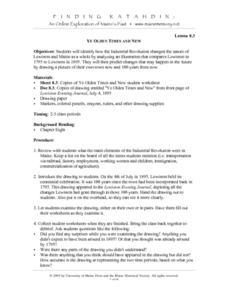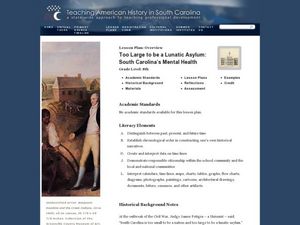DocsTeach
The Path of Justice: Selma and the Voting Rights Act
The civil rights movement: An ongoing battle for change. The activity focuses on President Johnson's speech in response to the massacre at the Selma March. Academics study the speech, complete a hands-on-activity, and discuss President...
DocsTeach
The Space Race: Project Mercury
Race to the moon! An engaging activity focuses on NASA's Project Mercury and the Space Race. Scholars read a memorandum regarding the project and explore how it fueled Cold War tensions. Academics complete a worksheet and discuss the...
Alabama Department of Archives and History
World War I and Alabama's Rainbow Division
As part of their study of World War I, class members investigate the role of Alabama's 167th Infantry Regiment, part of the Rainbow Division, in World War I.
DocsTeach
Analyzing a Writing Assignment by a Teenage Refugee in New York During World War II
Young historians delve into the world of teenage refugees during WWII to understand their experiences. The activity focuses on a writing assignment from a teen staying at a US refugee camp to explore the struggles they faced, such as...
DocsTeach
The Zimmermann Telegram
An enlightening activity explains how a telegram prompted the United States to enter World War I. Scholars examine the telegram and work to decode it. To finish, individuals complete a worksheet and participate in group discussion to...
Center for History Education
Speaking Freely In the Soviet Union's Autocratic Government
Speak your mind! The lesson explores the difference in free speech between the United States and the Soviet Union. Academics review the constitutions of both governments, political cartoons, and case studies to understand how freedom of...
Newseum
From the Front Page to the History Books
Young journalists compare news coverage of four major events with how the same events are covered in historical accounts. The ensuing discussion asks class members to compare and contrast the role of a reporter and the role of a historian.
Curated OER
Systems of Linear Equations
Introduce the inverse matrix method to solve systems of linear equations both algebraically and graphically. Using given data, your class checks their answers with graphing calculators. Handouts are included in this well-thought out...
University of Georgia
The Power of Peanuts
Measure the amount of energy in a peanut by igniting a chemical reaction. Classes use a laboratory setup to burn a peanut and measure the amount of heat it releases through a temperature analysis. They calculate the number of Joules of...
University of Georgia
Heating and Cooling of Land Forms
Compare heating and cooling rates of different land forms. A lab activity has groups collect data on the rate of heating and cooling of soil, grass, saltwater, fresh water, and sand. An analysis of the rates shows how the different land...
US National Archives
WWII: Western Europe 1939-45 – D-Day
D-Day, also known as the Normandy Invasion, was a true turning point for the Allied forces and one of the most successful campaigns of World War II. After researching the factors that contributed to the campaign's success, high schoolers...
US National Archives
WWII: The Atlantic 1939-45 – Battle of the Atlantic
The most dangerous line of attack during World War II wasn't the German planes soaring above Britain, but the U-Boats cutting off their supplies of food and equipment. Learners research the Battle of the Atlantic, the German campaign to...
University of Georgia
Flavor of Organic Chemistry
Introduce organic chemistry through an analysis of flavor. A three-part unit begins with an overview of the components of flavor. Next, scholars prepare esters through esterification. Finally, they examine how all senses have an impact...
Curated OER
Froggy Gets Dressed
In this reading comprehension instructional activity, 1st graders complete a variety of comprehension and vocabulary tasks: missing letters, short answers, yes/no questions, matching. All pertain to the Level 1.8 book Froggy Gets Dressed.
Curated OER
The Battle Over Reconstruction: The Politics of Reconstruction
High schoolers participate in a simulation as a Congress member to decide which policies to support in Reconstruction. In this Reconstruction era lesson, high schoolers read primary source documents to use as the basis for a mock debate....
Curated OER
Ye Olden Times And New
Students investigate the changes that occurred during the Industrial Revolution by comparing primary source documents from the Lewiston Evening Journal of 1895. They evaluate the document using a guided worksheet and discuss the changes...
Curated OER
Stitching Truth Lesson Two: The Arpilleristas in Pinochet's Chile
Students analyze arpilleras. In this Chilean history instructional activity, students examine social justice issues as they read and interpret arpilleras. Students study the tapestries to learn about Augusto Pinochet and his human rights...
Curated OER
Family Customs Past and Present: Exploring Cultural Rituals
Students examine cultural traditions. In this cultural studies lesson, students conduct interviews and research online digital tools that allow them to discover their family's cultural traditions. Students prepare presentations using...
Curated OER
Why We Chose Our Constitution
Students examine the American plan for government. In this American government lesson plan, students examine selected Internet websites regarding the Magna Carta, the Articles of Confederation, and the Constitution.
Curated OER
Baltimoreans in the California Gold Rush
Eleventh graders explore the reasons for migration to California during the Gold Rush. In this American History instructional activity, 11th graders read letters about the opportunities and obstacles people faced. Students...
Curated OER
Analyzing "A Furious Mob"
In this Stamp Act research worksheet, students examine a copy of "A Furious Mob," (not included) and respond to 6 short answer questions regarding its content.
Facing History and Ourselves
Identity and Belonging
High schoolers examine World War I war crimes. For this world history activity, students examine a painting by Ashile Gorky, a refugee from the Armenian genocide. High schoolers interpret the piece of art and discuss its historical...
National Endowment for the Humanities
Thirteen Ways of Reading a Modernist Poem
High schoolers analyze modernist poetry and the role of speaker in example poems. Learners study modernist poems from the Romanticism and Victorian periods as well as Wallace Stevens' "Thirteen Ways of Looking at a Blackbird." Using a...
Curated OER
Too Large to be a Lunatic Asylum: South Carolina’s Mental Health
Eighth graders examine the history of South Carolina's mental institutions. In this South Carolina history lesson, 8th graders discover details about asylums built in the state in the 1800's. Students analyze primary sources about mental...























